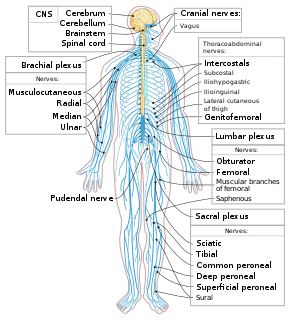The following diagram is provided as an overview of and topical guide to the human nervous system:

Human nervous system – the part of the human body that coordinates a person's voluntary and involuntary actions and transmits signals between different parts of the body. The human nervous system consists of two main parts: the central nervous system (CNS) and the peripheral nervous system (PNS). The CNS contains the brain and spinal cord. The PNS consists mainly of nerves, which are long fibers that connect the CNS to every other part of the body. The PNS includes motor neurons, mediating voluntary movement; the autonomic nervous system, comprising the sympathetic nervous system and the parasympathetic nervous system and regulating involuntary functions; and the enteric nervous system, a semi-independent part of the nervous system whose function is to control the gastrointestinal system.
Evolution of the human nervous system
editSome branches of science that study the human nervous system
editCentral nervous system
editThe central nervous system (CNS) is the largest part of the nervous system and includes the brain and spinal cord.
Brain
editBrain – center of the nervous system.
Principal regions of the vertebrate brain:
Peripheral nervous system
editPeripheral nervous system (PNS) – nervous system structures that do not lie within the CNS.
| Peripheral nervous system |
by direction | afferent system | |
| efferent system | |||
| By function | Somatic | ||
| Autonomic | Sympathetic | ||
| Parasympathetic | |||
| Enteric | |||
Sensory system
editA sensory system is a part of the nervous system responsible for processing sensory information. A sensory system consists of sensory receptors, neural pathways, and parts of the brain involved in sensory perception.
- List of sensory systems
- Sensory neuron
- Perception
- Visual system
- Auditory system
- Somatosensory system
- Vestibular system
- Olfactory system
- Taste
- Pain
Components of the nervous system
edit- Neuron
- Interneuron
- Ganglion (PNS) vs Nucleus (neuroanatomy) (CNS) except basal ganglia (CNS)
- Nerve (PNS) vs Tract (neuroanatomy) (CNS)
- White matter (more myelinated) vs Grey matter
Glial cells
editGlial cells, commonly called neuroglia or glia, are supportive cells that maintain homeostasis, form myelin, and provide support and protection for the brain's neurons.
- Microglia
- Astrocyte
- Oligodendrocyte (CNS) vs Schwann cell (PNS)
Neuron
editA neuron (also known as a neurone or nerve cell) is an excitable cell in the nervous system that processes and transmits information by electrochemical signaling. Neurons are the core components of the brain, spinal cord, and peripheral nerves.
Action potential
editAn action potential (or nerve impulse) is a transient alteration of the transmembrane voltage (or membrane potential) across the membrane in an excitable cell generated by the activity of voltage-gated ion channels embedded in the membrane. The best known action potentials are pulse-like waves that travel along the axons of neurons.
Synapse
editSynapses are specialized junctions through which neurons signal to each other and to non-neuronal cells such as those in muscles or glands.
Neurotransmitter
editNeurotransmitter – endogenous chemical that relays, amplifies, and modulates signals between neurons and other cells to which they are synaptically connected.
Neurotransmitter receptor
editNeurotransmitter receptor – membrane receptor that can be activated by a neurotransmitter. Interactions between neurotransmitters and neurotransmitter receptors can evoke a wide range of differing responses from the cell receiving the signal, including excitation, inhibition, and various types of modulation.
Biological neural network
editBiological neural network – population of physically interconnected neurons that act cooperatively to form a functional circuit. Computer scientists and engineers also study artificial neural networks formed by simplified mathematical abstractions of the signaling properties of biological neurons.
Neural development
editNeural development – comprises the processes that generate, shape, and reshape the nervous system, from the earliest stages of embryogenesis to the final years of life.
Prenatal development of the nervous system
editNeurogenesis
editEye development
editAuditory development
editMotor control
editMotor control – comprises the activities carried out by the nervous system that organize the musculoskeletal system to create coordinated movements and skilled actions.
Learning and memory
editMemory – organism's ability to store, retain, and recall information. "Learning" means acquiring new knowledge, behaviors, skills, values, preferences or understanding, and may involve synthesizing different types of information.
Cognition
editCognition – activities involved in processing information, applying knowledge, and changing preferences. Cognition, or cognitive processes, can be natural or artificial, conscious or unconscious.
Arousal
editArousal – physiological and psychological state of being awake or reactive to stimuli.
Anatomical structures of the human nervous system by subsystem
editCentral nervous system
edit- General terms
- Meninges
- Spinal cord
- Gray columns
- White substance
- Brain
Peripheral nervous system
edit- General termsi
- Cranial nerves
- Olfactory nerve
- Optic nerve
- Oculomotor nerve
- Trochlear nerve
- Trigeminal nerve
- Sensory root
- Ophthalmic nerve
- Maxillary nerve
- Mandibular nerve
- Abducent nerve
- Facial nerve
- Posterior auricular nerve
- Intermediate nerve
- Greater petrosal nerve
- Chorda tympani (also in trigeminal? redundancy?)
- Vestibulocochlear nerve
- Glossopharyngeal nerve
- Vagus nerve
- Accessory nerve
- Hypoglossal nerve
- Spinal nerves
- Cervical nerves
- Suboccipital nerve
- Greater occipital nerve
- Third occipital nerve
- Cervical plexus
- Brachial plexus
- Supraclavicular part
- Infraclavicular part
- Thoracic nerves
- Lumbar nerves
- Medial clunial nerves
- Sacral nerves and coccygeal nerve
- Cervical nerves
- Autonomic division (Autonomic nervous system)
- Sympathetic part
- Sympathetic trunk
- Superior cervical ganglion
- Middle cervical ganglion
- Cervicothoracic ganglion (Stellate - should prob. include inferior cerv. ganglion)
- Thoracic ganglia
- Lumbar ganglia
- Sacral ganglia
- Parasympathetic part
- Cranial part
- Pelvic part
- Pelvic ganglia
- Parasympathetic root of pelvic ganglia = Pelvic splanchnic nerves
- Pelvic ganglia
- Peripheral autonomic plexuses and ganglia
- Craniocervical part
- Thoracic part
- Abdominal part
- Pelvic part
- Sympathetic part